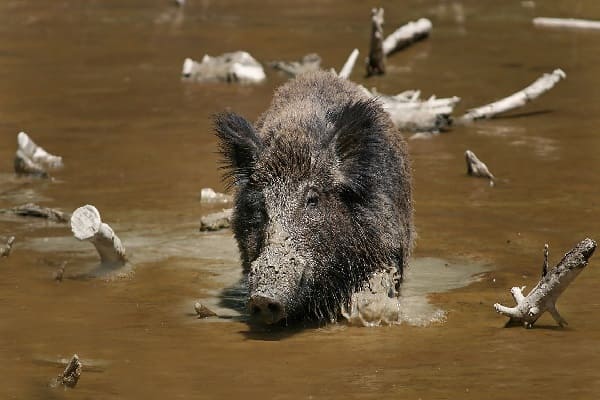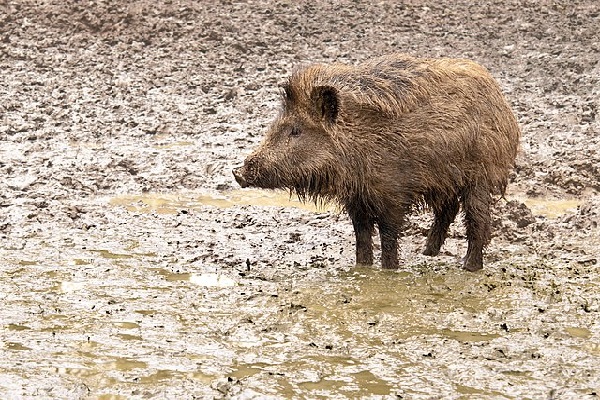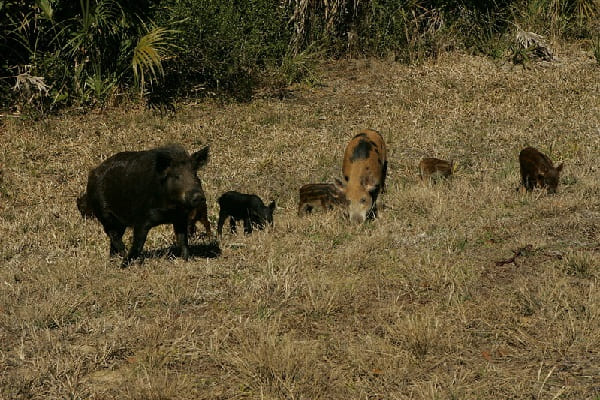
Have you ever wondered what goes on in the world of wild pigs? Join us as we delve into the fascinating behavior of these highly intelligent and adaptable creatures. Wild pigs, also known as feral pigs, are a species of pig that were originally domesticated but have since returned to the wild. They can be found all over the world, from the forests of Europe to the grasslands of Australia, and their behavior is both complex and intriguing.
Unlike their domestic counterparts, wild pigs are highly adaptable and intelligent animals that exhibit a wide range of behaviors in the wild. From the social hierarchies of wild sow groups to the aggressive territoriality of mature boars, wild pig behavior is as varied and complex as it is fascinating. So, this article will explore how do pigs behave in the wild and discover the many ways in which they have adapted to survive in the wild.

Understanding wild pig social structure
Understanding wild pigs social structure is an important aspect of studying their behavior. Wild pigs are social animals that live in groups, and their social structure can be quite complex. Wild pig social structures vary depending on the species, as well as factors such as habitat and availability of resources.
Wild pigs are descended from domestic pigs, and as a result, their social structure is similar in many ways. Like domestic pigs, wild pigs form social hierarchies, with dominant animals exerting control over subordinate ones. In some wild pig species, such as the wild boar, the hierarchy is based on physical dominance and strength, with larger and more aggressive individuals dominating smaller, weaker ones.
Wild sows, on the other hand, tend to form groups based on familial relationships. Mother pigs will typically raise their piglets in close-knit groups, with other related females helping with the care and protection of the young. As the piglets grow, they may establish their own social hierarchies within the group, which can sometimes lead to conflicts and aggression. Understanding the intricacies of these social structures is key to gaining insights into wild pig behavior and their survival strategies in the wild.

Foraging and feeding habits
Foraging and feeding habits are important aspects of wild pig behavior. Wild pigs are opportunistic omnivores, which means they will eat just about anything they can find. Their diets can include everything from roots and tubers to small animals and carrion.
One of the biggest concerns surrounding wild pig foraging and feeding habits is their impact on agricultural crops. Wild pigs can cause significant damage to crops, especially in areas where agriculture is a major industry. They are often found wallowing, socializing, playing, squealing, or fighting in the mud. In some cases, the damage can be severe enough to threaten food security and livelihoods. Farmers and agricultural agencies often use a variety of methods to deter wild pigs from accessing crops, including fencing and traps.
In some regions of the world, wild pigs have become an invasive species that is difficult to control. For example, the Eurasian wild boar has been introduced to many parts of the world, including the United States, where it is considered a destructive invasive species. The foraging and feeding habits of these animals have contributed to their success in colonizing new areas and thriving in a variety of habitats. Understanding their dietary preferences and feeding behaviors is essential to managing the impact of wild pigs on local ecosystems and communities.

Reproduction and maternal care in wild pigs
Reproduction and maternal care are key aspects of wild pig behavior, and understanding them is crucial to managing and conserving wild pig populations. Wild pigs have a relatively short gestation period, usually around three months, and can produce large litters of piglets. This reproductive capacity, coupled with their adaptability and wide-ranging diet, has contributed to their success as a species.
Pregnant sows typically build nests in which to give birth, and they will aggressively defend their young against predators. This maternal care is crucial to the survival of piglets, who are vulnerable to predation by animals such as coyotes and foxes. However, the foraging and rooting behaviors of wild pigs can also have negative impacts on other species, such as ground-nesting birds that rely on similar habitats.
In some regions of the world, wild pig populations have become overabundant, causing a range of ecological and economic problems. Understanding the reproductive behavior and maternal care of wild pigs is essential to developing effective management strategies that balance the needs of both wild pigs and other species. By managing wild pig populations, we can help reduce the impact of these animals on local ecosystems and protect the biodiversity of the areas in which they live.

Interactions with other animals
Wild pigs are known to interact with a variety of other animals in their environments, and these interactions can have important ecological and behavioral implications. In many cases, wild pigs will interact with other pigs, both wild and domestic. These interactions can be both positive and negative, with wild pigs sometimes competing with domestic pigs for resources such as food and water.
In some regions of the world, feral hogs are a major concern due to their impact on other species. Feral hogs are domestic pigs that have gone wild, and they can have a devastating impact on ecosystems. They are known to prey on young animals such as deer fawns and ground nesting birds, and they can also cause significant damage to crops and other vegetation.
Wild pigs also interact with other animals in less direct ways. For example, their rooting behavior can create habitats for other species, and their feces can provide important nutrients for plants and insects. Understanding the complex interactions between wild pigs and other animals is an important aspect of studying their behavior, as it can help us better understand the ecological role of these animals and their impact on local ecosystems.
The impact of human activity on wild pig behavior
Human activity can have a significant impact on the behavior of wild pigs, and in some cases, can contribute to their overabundance and negative impact on ecosystems. One of the key factors affecting wild pig behavior is poor food supplies. When natural food supplies are limited, wild pigs may actively seek out alternative sources of food, such as agricultural crops, garbage dumps, or even suburban gardens.
In many areas, human activity has also resulted in changes to the landscape that favor wild pig populations. For example, the construction of roads and other infrastructure can create new habitats and corridors for wild pigs, making it easier for them to move into new areas. Similarly, the introduction of non-native plant species can provide a food source for wild pigs, contributing to their success as an invasive species.
The impact of human activity on wild pig behavior can also have important implications for public safety. Wild boars, for example, have been known to cause traffic accidents and other hazards in areas where human activity and wild pig populations overlap. Understanding the ways in which human activity can affect wild pig behavior is essential to developing effective management strategies that balance the needs of both human populations and wild pig populations.
Need Help With Wildlife On Your Property?
Do you need help managing wildlife on your property? If you’re experiencing issues with intensive and prolonged disturbances caused by wild animals, AAAC Wildlife Removal Services can help. Our experienced wildlife professionals are trained to identify and resolve a wide range of wildlife issues, from unwanted visitors digging up your yard to destructive animal activity that threatens your home.
Our services are available 24/7, so whether you’re dealing with early morning animal activity or late-night disturbances, we’ll be there to help. We use humane and effective removal techniques that are tailored to the specific needs of your property and the animal species involved. Whether you’re dealing with small animals or larger ones, our experts have the experience and expertise to handle animals of all body weights.
Don’t let wildlife take over your property. Contact AAAC Wildlife Removal Services today and let us help you restore peace and safety to your home. With our professional and reliable services, you can trust that we’ll take care of your wildlife issues quickly and effectively, so you can get back to enjoying your property with the peace of mind that comes with knowing it’s protected from unwanted animal activity.
Final Thoughts
In summary, wild pig behavior is a complex and multifaceted subject that encompasses a wide range of topics. One key area of study is the social behavior of wild pigs, which includes the formation of basic family groups and the care of newborn piglets. Understanding the dynamics of these social structures is essential to managing wild pig populations and minimizing their impact on local ecosystems.
Another important aspect of wild pig behavior is their foraging and feeding habits. Wild pigs are opportunistic omnivores and will eat a wide range of foods, including agricultural crops, which can create problems for farmers and other landowners. Managing wild pig populations and their impact on local vegetation requires a deep understanding of their feeding habits and the factors that influence their behavior.
Finally, the interactions between wild pigs and other animals, as well as the impact of human activity on their behavior, are critical areas of study for understanding and managing wild pig populations. By understanding the complex interplay between wild pigs and their environment, we can develop effective strategies for managing these animals and minimizing their impact on local ecosystems.







